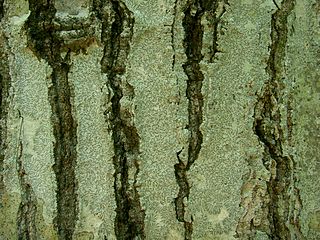
The Leotiomycetes are a class of ascomycete fungi. Many of them cause serious plant diseases.
Scutula is a genus of lichenicolous fungi in the family Ramalinaceae.
Biatorellaceae is a family of lichen-forming fungi in the subclass Lecanoromycetidae. The family is monotypic, and contains the single genus Biatorella, which contains eight species.

The Ostropomycetidae are a subclass of mostly lichen-forming fungi in the class Lecanoromycetes. The subclass was circumscribed in 2004 by Catherine Reeb, François M. Lutzoni, and Claude Roux. It contains ten orders and 36 families.
Frutidella is a genus of lichen-forming fungi in the family Ramalinaceae. It contains three species. The genus was circumscribed in 1994 by Klaus Kalb to contain the species formerly known as Lecidea caesioatra.

Toniniopsis is a genus of crustose and squamulose lichens in the family Ramalinaceae. The genus was circumscribed by Swiss lichenologist Eduard Frey in 1926, with Toniniopsis obscura designated the type and only species. The genus name of Toniniopsis is in honour of Carlo Tonini (1803–1877), who was an Italian chemist and botanist (Lichenology), who worked in Verona and was a member and President of the Academy of Agriculture. As a result of molecular phylogenetic studies, several species, formerly classified in genus Bacidia, have been transferred to Toniniopsis.

Toninia is a genus of lichen-forming fungi in the family Ramalinaceae.

Placidiopsis is a genus of lichens in the family Verrucariaceae. The genus was circumscribed by Italian naturalist Francesco Beltramini de Casati in 1858, with Placidiopsis grappae assigned as the type species.

Flavopunctelia is a genus of foliose lichens in the family Parmeliaceae. The genus contains species that are widespread in temperate and tropical areas. The genus is characterised by broad, yellow-green lobes, point-like (punctiform) pseudocyphellae on the thallus surface, and bifusiform conidia. All species contain usnic acid as a major secondary chemical in the cortex. Flavopunctelia was originally conceived as a subgenus of Punctelia by Hildur Krog in 1982; Mason Hale promoted it to generic status in 1984.

Miriquidica is a genus of lichen in the family Lecanoraceae. The genus was circumscribed in 1987 by lichenologists Hannes Hertel and Gerhard Rambold, with Miriquidica complanata assigned as the type species. According to Dictionary of the Fungi, the widespread genus contains 23 species, found predominantly in arctic-alpine regions.
Stenocybe is a genus of fungi in the family Mycocaliciaceae. It has 14 species.

Gyalidea is a genus of crustose lichens in the family Gomphillaceae. It has 50 species.

Solorina is a genus of 10 species of lichenized fungi in the family Peltigeraceae. The genus was first described by the Swedish botanist Erik Acharius in 1808. Members of the genus are commonly called socket lichens.
Coppinsidea is a genus of two species of crustose lichens in the family Ramalinaceae. It was circumscribed in 2019 by lichenologists Sergey Kondratyuk, Edit Farkas, and Laszlo Lőkös with Coppinsidea sphaerella designated as the type species. Species of Coppinsidea are similar in appearance and morphology to Thamnolecania, but differ from them in having a thallus that is crustose, mostly convex to almost spherical apothecia that are lecideine or biatorine in structure, as well as in being distributed in the Northern Hemisphere.

Alyxoria is a genus of lichen-forming fungi in the family Lecanographaceae.

Hymenelia is a genus of lichen-forming fungi belonging to the family Hymeneliaceae.

Halecania is a genus of fungi in the family Leprocaulaceae. It has 22 species. The genus was circumscribed by Austrian lichenologist Michaela Mayrhofer in 1987, with Halecania alpivaga assigned as the type species. She created Halecania to contain species, formerly placed in Lecania, with the following characteristics: uniformly amyloid apical domes, paraphyses with dark brown apical caps, and halonate ascospores.

Stereocaulon saxatile is a species of snow lichen belonging to the family Stereocaulaceae.
Protothelenella is a genus of fungi in the family Protothelenellaceae. It contains 11 species, some of which form lichens. Protothelenella species have a crustose thallus with spherical to pear-shaped, dark brown to blackish perithecia. Microscopic characteristics of the genus include bitunicate asci with an amyloid tholus, and ascospores that are colourless and contain multiple internal partitions. Some species grow on acidic substrates including rocks, soil, bryophytes, plant detritus or rotten wood. Other species are lichenicolous (lichen-dwelling), growing on species of Solorina, Peltigera, Pseudocyphellaria, or Cladonia.

Thalloidima is a genus of lichen-forming fungi in the family Ramalinaceae. It has 13 species.













